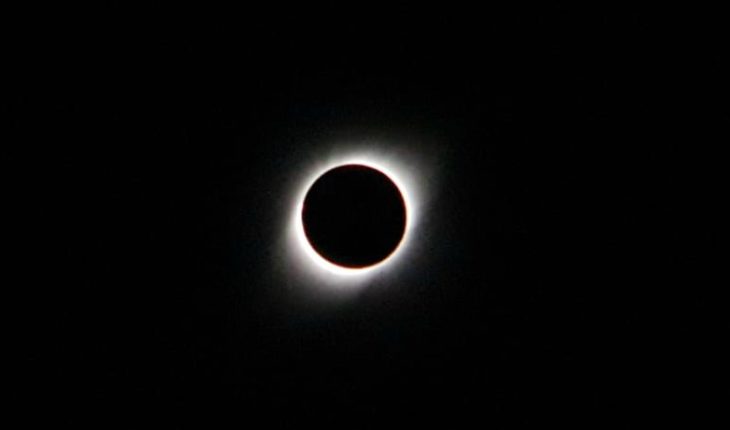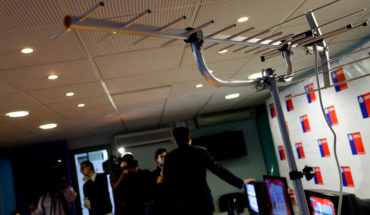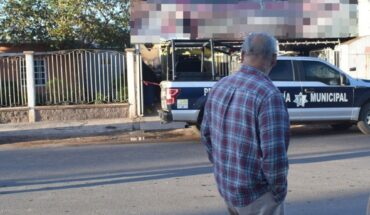“Adjust your seat belts, because in the next few minutes we will experience total darkness,” says Kathernine Kairath, flight crewman who at 16:39 with 15 seconds would have a privileged view of the solar eclipse. Amid the applause is the astronomer and national science award, María Teresa Ruiz, looking out the window in silence with her cell phone in her hand. “By the last eclipse, I was in the garden of my house and I had some burnt glass that I had done the night before to see it, but when it started to darken all the birds went crazy and that deflected my attention, so I didn’t even look at the sun” says and smiles. He adds that it will now be like “meeting a friend”. “It annoys me when people write it in lowercase, because that’s their name. We always complain about the “Sun”, which warms a lot, that makes us bad for the skin, but without the sun there would be no life”, he muses. The plane takes an air route northward and then 300 kilometers to the coast. The plan of Klaus Von Storch, the pilot in charge of this experience, is to intercept the eclipse at 850 kilometers per hour and 39,000 feet high to an event that goes 10 thousand kilometers per hour (three times faster than a missile). The only thing that could slow down planned was the wind. “What happens is that above there are jets, which change according to the climate, therefore, they do not affect mostly what is the movement of the plane. Today (yesterday) the wind is from the south, which means we’re going to take less time to get there, so we have to recalculate to be at the right time,” says the first Chilean astronaut and captain of the flight. To achieve the route laid out, NASA experts worked alongside the pilot for a year and yesterday, before boarding, they recorded all the winds of the aircraft’s route and entered them into a computer. The plane is a charter and the passengers sit on the left. As planned, the first images of the eclipse are seen on the right. Chaos takes over the flight. Most change seats and hear cries from the former who manage to portray the eclipse with their cell phone. This flight is produced by Nat Geo and has cameras to record every detail inside and outside. Another commercial aircraft, flies 300 meters lower than ours and also captures the movements of this aircraft. On board there are also 10 winners of a Samsung contest, who were able to catch the sun with an S10 phone. One of them had never traveled by plane. A partial eclipse is already appreciated and Jorge Salas, one of the winners of the contest says: “I’ve taken seven photos, I’m waiting for the full eclipse to take the best picture. It’s unbelievable all this. I’m very interested in astronomy. I’m excited.” A little further is the singer-songwriter Gepe, standing in the middle of the hallway, waiting for one of the windows on the right to undo. “It’s beautiful what surrounds all this. It wouldn’t have occurred to me that this could happen. For the last eclipse I was at school and I saw it through a floppy bed hahahaha… I’m trying to take a picture, see if it comes out,” he says. Von Storch announces, as loudspeaker, as the moment approaches: “We will take the westward turn, to start the right turn and thus be perpendicular to the sun. This is going to happen when it’s 16:08. We’ve got 200 kilometers left.” We return to the left; The important thing is about to happen. We’re over the sea, 400 nautical miles inland from the Pacific Ocean. “In a few more seconds you will be able to enjoy this wonderful event,” the pilot tells the rest of the passengers. Through the window you can see how the 200 kilometers of shadow are projected onto the Earth’s surface. The sun is completely covered and you can see the perfect halo. Now we can take off our glasses and look directly at the sun. It’s only two minutes and thirty seconds of perfect alignment. Applause announces that the climax of the event passed and that the plane is heading back to Santiago.” It met my expectations. Looking at him without the glasses was exciting. The light, the shadow, the umbra. Much better than the ’94’. She (Maria Teresa Ruíz) was very focused, she was in her sauce, it was difficult to interrupt her”, sums up Gepe, who was going ahead of the scientist. Ruiz sums up his experience: “I loved not only the eclipse itself, but all the scenery that looked. That colorful, red horizon and the dark sky with stars and black clouds that could be seen. A spectacle. I found it beautiful, an experience that is a life surprise. It’s a unique moment. It gave me excitement.” A “ceacheí” marks the return flight, led by loud speaker Kairath, who also closes with an emotional speech: “Welcome to Santiago, we arrive with the goal fulfilled and the heart full of gratitude that we have had the possibility of having appreciated a phenomenon as incredible as this, the one I know we will never forget.”On the other planePhotographer María Gracia Subercaseaux traveled on the other aircraft, which went a thousand feet below, and told SoyChile how she achieved the best of her photos of the event. “When the sun was completely covered, I took the filters out of the camera. What I wanted was to contextualize the sun, to help me in the composition. The clouds we had were amazing. It was all perfect, sublime. You could see a lot of colors, I decided to put that in the photo and started shooting many times. I put the camera horizontally and not vertically so that the clouds could be seen,” he says. Read also: (PHOTOS) Best flight records “Into the Dark, trip to the eclipse”
translated from Spanish: The eclipse from a plane at 39,000 feet
July 3, 2019 |





